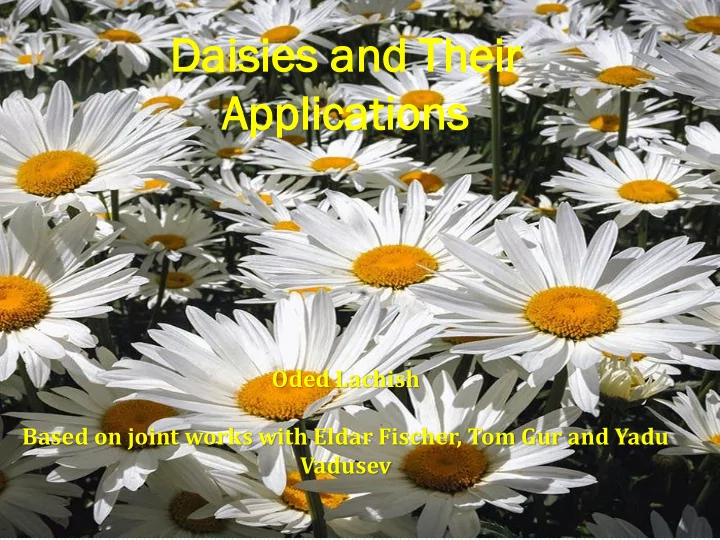

Daisies sies and Their ir Applications lications Oded Lachish Based on joint works with Eldar Fischer, Tom Gur and Yadu Vadusev
Setting Sublinear algorithms Complexity parameter: Query complexity Property testing (relaxed) Locally decodable codes Querying versus Sampling Querying – “smart” selection of queries that depends on the goal. Sampling – every bit is sampled independently with the same probability.
Querying versus Sampling Querying – “smart” selection of queries that depends on the goal. Result - optimal use of queries , but queries are not guaranteed to be reusable! Sampling – every bit is sampled independently with the same probability. Result - wasteful use of queries , but queries are reusable! We are interested in converting Querying algorithms to sampling algorithms
Converting Querying to Sampling Implications (mostly due to reusability): GL’19 - Lower bounds on relaxed locally decodable codes FLV’14 – for every testable property there exists a non- trivial tester: Multi-testing – can use o(n) samples for testing >>> n testable properties Privacy – query oracle can’t tell which property is tested Union of very a large number of testable properties is non-trivially testable
Conversion: naïve idea Setting : Input alphabet is {0,1} Querying algorithm is non-adaptive and can be viewed as selecting a set of queries from a distribution over sets of queries of size q Todo : Prove a volume lemma or two – the union of sets in the support that are “good” is large (their union is linear in the input size n ) Prove that, with high probability, a set of samples contains a “good” set of queries
Very wishful thinking The sets in the support of the distribution are pairwise disjoint. Sampling should work if The union of the “good” sets is linear in the input size − 1 Sampler probability is about is about 𝑜 𝑟
Petal Problem: Sunflowers A family of sets S is a sunflower if there exists a set K such that the intersection of every pair of distinct sets in A,B in S is K . What if the support of the querying algorithm is a sunflower. Kernel The probability of sampling the Kernel is too small. So, forget about seeing a set from the support.
Actually sunflowers are nice Petal What if the support of the querying algorithm is a sunflower. The probability of sampling the Kernel is too small. So forget about support. However, there is a good chance of sampling a whole petal, and in the settings of our interest, changing a few bits in the input doesn’t change the results of the Kernel algorithms by much (or at least nothing we can’t handle)
Petal Sunflowers Suppose the problem was checking whether a crossword puzzle is filled correctly or far from that. Every set is supposed to be a natural language word. If it is far from being filled correctly, for every Kernel guess of the letter in the kernel, with high probability, the sample is going to contain a petal that rules it out.
The PROBLEM with sunflowers The support may not be a sunflower. Ideally, we would like to partition the family of sets into poly(q) disjoint sunflowers. Solution: look for other flowers
Daisies (Wikipedia) “The species habitually colonises lawns”, and “is difficult to eradicate by mowing – hence the term 'lawn daisy'. Wherever it appears it is often considered an invasive weed.” “The flower heads are composite”
Simple Daisy A family of sets S is a simple daisy if there exists a set K such that the intersection of every pair of distinct sets in A,B in S is a subset of K . Petal Same ideas as before work if there are enough petals. Problem: finding simple daisies. Kernel
t-daisy A family of sets S is a t-daisy if there exists a set K such that any x outside is in at most t petals. The advantages of t -daisies. We can actually partition the support of the query algorithm into daisies and we can extract simple daises from them. Kernel
t-daisy partition lemma (Important – the sets are the sets in the support that the querying algorithm uses, we assume there number is cn c- constant, n size of input ) Let S be the support. The kernel of the first daisy K 1 , is the 1 set of every x that is in at least 𝑑𝑜 𝑟 sets from S . n - is the size of the input, C - is a constant The daisies sets are the sets of S That have an intersection of size q-1 or more with K . Kernel
t-daisy partition lemma Remove the sets of daisy i-1 from S . The kernel of the i’th daisy K i , is the set of every x that is in at least 𝑗 𝑟 sets from S . 𝑑𝑜 The daisies sets are the sets of S that have an intersection of size exactly q-i with K .
Thank You
Recommend
More recommend